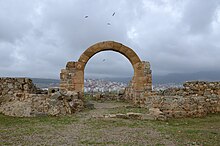Tamuda
 Roman amphora and mosaic of Tamuda, in the "Archaeological Museum of Tetouan" | |
| Location | Morocco |
|---|---|
| Region | Tanger-Tetouan-Al Hoceima |
| Coordinates | 35°33′30″N 5°24′35″W / 35.55833°N 5.40972°W |

Tamuda was an ancient
History
The ancient city was founded in the 3rd century BC by the
Under the Emperor
Tamuda became later one of the major cities of the Roman province Mauretania Tingitana and enjoyed a development during Trajan and Septimius Severus rule. It was used for fish salting and purple production, according to researcher from the University of Cadiz.[4] On the Notitia Dignitatum, written in the fifth century, it is stated that at the end of the fourth century Tamuda's castrum was the headquarters of an "Ala Herculea" (cavalry unit) of local limitanei and that was related to a cohortes of Lixus.
The region around Tamuda was fully Romanized, Christianized and "pacified" during the fifth century and the fort probably was dismantled. By the time the
In the late 13th century small fortifications existed near the Roman ruins with the name "Tittawin", that later were renamed "Tetouan".[6]
Excavations
Artifacts from both the
In 1933, a third century (circa 253-257 A.D.) stone recording a Roman victory over some unnamed barbarians was discovered at the site of Tamuda. It is believed that the inscription refers to the Franks.[8][9]
In July 2018, a group of researchers discovered at the site a rib fragment from a North Atlantic right whale dated from 180 A.D. 396 A.D.[10] They suggest that the Romans may have conducted industrial-scale whaling in the coasts of the Western Mediterranean.[11]
See also
- Lixus
- Tingis
- Septem
- Rusadir
- Sala Colonia
- Mauretania Tingitana
- Christian Berbers
References
- ISSN 1989-9947.
- OCLC 476143018.
- ^ Archaeological Museum of Tetouan: Tamuda
- ^ Tamuda excavations
- Junta de Andalucía. p. 29.
- ^ Tittawin, Halima Ferhat, "The Encyclopaedia of Islam", Vol. X, ed. P.J. Bearman, T. Bianquis, C.E. Bosworth, E. van Donzel and W.P. Heinrichs, (Brill, 2000), 549.
- ^ M. Tarradell, El poblamiento antiguo del Rio Martin, Tamuda, IV, 1957, p. 272
- ^ The Classical Weekly, Volume 32 (p.239) - Classical Association of the Atlantic States, (1939)
- OCLC 264420871.
- ^ "Ancient Romans Hunted 'Sea Monsters.' Were They Whales?". Retrieved 2018-10-10.
- PMID 30051821.
Bibliography
- El Azifi, M.R. L'habitat ancien de la vallée de Martil in "Revue de la Faculté des lettres de Tétouan", année 4, n° 4 Tetouan, 1990


